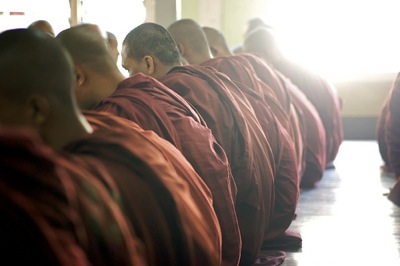Curfews are still in effect for many monasteries and in some cases monks may not go on alms rounds without government permission or surveillance.
The regime continues to outlaw the chanting of metta (loving-kindness) in public. Certain religious discourses—those deemed to be indirect critiques of the regime, such as describing the qualities of good kings or the conditions for the decline of the religion—have also been banned. Monks must ask permission to give public discourses. In Mandalay in December 2009, the Mahanayaka state monks committee issued a ban on posters advertising religious talks by monks. The junta continues to use the officially sanctioned and carefully culled state monks association to enforce policies on the Buddhist order, or Sangha. This deployment of monks aligned with military authorities has created fissures within the Sangha as they are regarded, especially by young activist monks, as corrupt government stooges.
The regime has also continued to arrest monks believed to have participated in the Saffron Revolution or who have otherwise criticized the government. The Thailand-based Assistance Association for Political Prisoners (AAPP) estimates that 253 monks and an unknown number of nuns remain in prison. Thirty monks were arrested at the two-year anniversary as the regime sought to discourage potential demonstrations. The regime has also paid closer scrutiny to lay persons visiting monasteries to make offerings or pay respects to monks. Abbots of monasteries have been forced to sign letters affirming that they will not lead the laity in protests against the government or join political parties, and young monks suspected of inclinations to become politically involved are encouraged to disrobe. This is a well-worn pattern in Burmese political history, where monks are expected to abstain from worldly, and especially political, affairs.
All these trends contribute to an atmosphere of intimidation and fear surrounding religious practice.
The regime’s long-term policy for controlling perceptions of the state’s role in religion is a mixture of maintaining the appearance of pious rulers who maintain the purity of Buddhism and a simultaneous subversive strategy of driving a wedge between monks and lay supporters by disrobing monks accused of acting politically, and therefore impurely. Since the 1990s the military has sought to demonstrate their political legitimacy in Buddhist terms through acts of pagoda building and repair, acting as chief donors to the Sangha, offering religious titles and scholarly examinations, missionary work and other sundry pious acts befitting ‘good kings’. The sincerity of the authorities’ actions has been the subject of public debate for some time.
But for most Buddhists in Burma the terms of political legitimacy have unequivocally shifted: there is no longer any pretence about the present rulership being righteously Buddhist. The military rulers are seen as anti-Buddhists. This is terrible news for the government. Monks have defied restrictions by continuing to offer discourse describing the ways religious decline begins with the evil actions of a country’s ruler. Cyclone Nargis, the natural disaster of May 2008, is held up as a sign of the material destruction that accompanies the moral decline of rulers.
Finally, the Saffron Revolution has also created another previously under-developed though incipient movement within the Sangha. Monk unions and associations have seen a proliferation of activity inside and outside the country. The most significant of these include the Sasana Moli and the All Burma Monks Alliance, which have developed strong international branch organisations. Unfettered by domestic media censorship, these Burmese monks’ organisations have given international voice to the religion’s legitimate claim against an oppressive anti-Buddhist regime, which has been impossible for the silenced Sangha inside the country.
Perhaps the most important contribution of these organisations has been to weave together multiple strands of discourse about political legitimacy: strands that the regime once successfully kept separate. A more unified struggle for political freedoms in Burma has emerged with a more collective public perception of political oppression and the diminished legitimacy of Burma’s rulers. A Buddhist, democratic as well as minorities-focused protest movement is finding its foundations in a single framework. Monks outside the country are speaking on behalf of democracy, in support of human rights in Burma, and in support of imprisoned monks as well as refugees.
The government has lately officially nullified the 1990 elections in which the National League for Democracy won 392 out of 495 parliamentary seats. The Constitution that was pushed through in the days following Cyclone Nargis remains contested. But the regime continues to use this Constitution as a means of entrenching their power by claiming 25 per cent of parliamentary seats for the military and banning Aung San Suu Kyi and other political prisoners from participating in the upcoming elections.
These actions have been widely condemned by the international community. Only time will tell if the junta’s game of seeking legitimacy internally through ‘participation’ in religious affairs, and externally by enacting democratic elections, will keep them in charge.
Ingrid Jordt is Associate Professor of Anthropology at the University of Wisconsin, Milwaukee.

